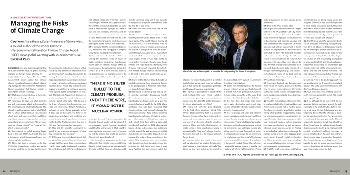MANAGING THE RISKS OF CLIMATE CHANGE
 Gary Yohe, Woodhouse/Sysco Professor of Economics, a co–lead author of the United Nations’ Intergovernmental Panel on Climate Change Report (IPCC) views global warming with an economist’s eye.
Gary Yohe, Woodhouse/Sysco Professor of Economics, a co–lead author of the United Nations’ Intergovernmental Panel on Climate Change Report (IPCC) views global warming with an economist’s eye.
DAVID PESCI: For any skeptics reading this, let’s start with the facts. Is global warming real and are human beings affecting it?
GARY YOHE: Yes, and yes. The third IPCC Assessment Report stated that climate change is real and we were already observing its impacts. The fourth IPCC Assessment Report concluded that human activity is causing the climate to change.
DP: What is an economist doing at the center of the climate change debate?
GY: I am trying to figure out what the risks are and how people adapt and respond to the manifestations of climate change. The climate is getting warmer, but so what? Well, the “so what” is that there are risks involved short term and long term that could have significant economic impacts. For me it’s a very natural progression from, “We are experiencing climate change” to, “How will this affect us economically?”
DP: Your interest in global warming began back in the early 1980s. As I recall, that was a time when scientists universally were predicting a global cooldown.
GY: There had been a concern in the late 1970s that the earth was cooling and another ice age could be on the way. But the scientific community looked more closely at that possibility and determined that the mini–ice age theories didn’t stand up. Meanwhile, the Keeling data from Mauna Loa showed increasing levels of atmospheric carbon dioxide in Hawaii—a location with no concentrated industrial base. Those data indicated an increased probability of a worldwide warming trend caused by the consumption of fossil fuel. The National Academy of Sciences began to investigate the question by commissioning a panel in the early 1980s to look at the drivers of carbon dioxide emissions over a 100–year time frame. William Nordhaus, a professor of mine during graduate school at Yale, was on the panel. He knew of my research on uncertainty and modeling economic decisions and asked me to become involved in the Academy report. That was in 1981 and I’ve been involved ever since.
DP: How did the scientific community respond to an economic viewpoint of what they considered their domain?
GY: With some degree of skepticism at first. But part of the beauty of that small committee was that there were three economists on it with some really hard–nosed scientists. We got to know each other’s vocabulary and each other’s needs, and from that a conversation began. After five or six years, many in the scientific community started to see some value in what we were trying to do. These issues are very complex, of course, and the conversations took an enormous amount of time. As I became involved with the U.N., the conversations became much longer, and participants came from all over the world.
DP: In the early ’90s the correlations between CO2 emissions and rising global temperatures started to attract more attention.
GY: Yes, and my work started to shift to assessing the economic costs of major impacts, including considering how humans would adapt to climate change, either autonomously or through planned policy decisions. I did a lot of work with sea level rise risk assessments. For example, some of the extremists said that continued sea level rise could put Kennedy Airport underwater. But Kennedy Airport would not be allowed to go underwater simply because somebody would build a wall around it. That would involve significant economic costs, to be sure, but not the billions that would be sacrificed if the airport were abandoned.
We can’t rely on adaptation to eliminate all the risks that climate change could bring, though. In fact, the report we just released in Brussels said that there are a lot of possible climate scenarios along which our capacity to adapt would simply be overwhelmed over the next 50 to 100 years.
DP: What does the future look like for the United States?
GY: The near–to–middle–term future is less troubling for the United States than it is for many parts of the world. We are looking at an increase of 2–3° C over the next 70 to 80 years; and a period of modest warming and no decline in precipitation could be experienced through, say, 2030 or so. Agriculture could actually become more productive because higher levels of CO2 help plants to grow faster. Eventually, though, even these benefits will begin to abate. Moreover, even if we are not severely impacted through direct climate change, what will be happening in the rest of the world could make us uncomfortable at home.
DP: You’ve testified before the U.S. Senate on multiple occasions. Have you seen a change in the perspectives of American policy makers toward climate change?
GY: Resistance to climate policy has, up until recently, dominated discussions “inside the beltway.” In some cases, politicians have looked at climate policy as a ploy for a redistribution of wealth by the U.N. Many politicians have also been concerned that climate policies could seriously damage the American economy. Many of these concerns have begun to melt away. Climate is no longer a Democratic or Republican issue. In fact, I don’t think there will be a successful presidential candidate in 2008 who doesn’t have a climate action plan. Our politicians on both sides of the aisle are recognizing that climate risks are real, and to delay action is to increase the costs of doing something in the future. This recognition need not translate into slamming on the brakes and grinding the economy to a halt in the short term. It does mean “getting the train moving out of the station.” To make this happen in a realistic and effective way we need to set up a climate policy that cannot be manipulated politically, and I support imposing a carbon tax.
DP: This may be a good time to talk about the pink elephant in the room—China—which is notorious for ignoring environmental measures. How does the U.N. get the Chinese to try to pay attention to any of this?
GY: That’s not only the pink elephant, it’s the $64 billion question. I think if the United States commits itself to a comprehensive climate policy, then carbon will get more and more expensive year in and year out and it will become clear to countries such as China and India that ignoring climate policy in their development plans is unsustainable. They won’t change their behavior in the next 5 or 10 years, but they’ll figure it out.
DP: You said earlier that much of the world will pay attention if we create a climate policy that “cannot be manipulated politically,” but there are few if any policies ever created in this nation that aren’t subject to some form of political manipulation.
GY: Except for monetary policy. The Federal Reserve System is set up specifically to avoid, or at least minimize, political manipulation. Climate policy should be at the same level, not just in the United States but globally.
DP: So then does that mean that energy policy, water distribution policy, and other policies affected by climate would become driven by climate policy?
GY: No, but energy and water and other resource management decisions would have to take climate change and climate policy into account. This is why I favor taxes rather than a cap and trade mechanism for restricting emissions. Cap and trade means allocating permits across thousands of points of consumption; it would be an administrative nightmare, and the signal of higher carbon prices would be obscured by volatility in the permit market. Taxing the carbon as it enters the energy system is simple, and it sets up all of the right incentives. People make adjustments to clear signals across all markets.
DP: What is the IPCC process like?
GY: I’m glad you asked that question. The perception of the IPCC is that it’s this big monolith with one view of the world. It would be really instructive if people could attend one of the meetings and listen to us argue with each other. There is no single view. Ultimately we come out with an assessment of the literature. We report what we find convincing and what we don’t. We highlight strengths and weaknesses. We identify where the next round of research should be focused. And we argue with each other every step of the way. We’re all professional skeptics by training, and it can become quite intense. It is, though, extremely gratifying and always a real education. Some of my best work has come from collaborations that were born at IPCC authors’ meetings.
DP: France and England have become much more reliant on nuclear power. For the first time in years, conversations in the United States have come back to perhaps building more nuclear power plants. Does this figure into the equation?
GY: The other pink elephant in the room. There is no silver bullet to the climate problem, and if there were, it would not be nuclear power. To reduce emissions to any effective level we need a whole portfolio of approaches, including energy conservation, investments in energy efficient production processes and buildings, increased mileage, carbon sequestration, more use of natural gas and less carbon–intensive energy sources, and so on. Nuclear is certainly a low carbon source of energy. But nuclear carries a lot of other baggage: plant safety, waste disposal, global proliferation, etc. These are policy issues that complicate any scenario that envisions increased reliance on conventional nuclear energy.
DP: That this is all being done, and that recommendations are being issued under the auspices of the U.N. has caused skepticism in more than a few places. In fact, the prime minister of Australia and his environmental minister recently claimed that IPCC was “the newest version of the Spanish Inquisition.” How do you answer such charges?
GY: The IPCC is a scientific assessment body, so it is precluded from being policy prescriptive. We’re not allowed to tell anybody what to do. We’re trying to provide information to inform decision–makers about the risks and the consequences if they fail to act. The chapter for which I am the coordinating lead author is about sustainability, and its subtext essentially offers a road map for countries to get climate policy out of the environment ministries and into the finance ministries. The risk management approach that frames our assessment allows us to say to anyone who is listening, “This is the kind of approach you are already using for all your other important issues.” The facts speak for themselves. We don’t need to suggest policy.
DP: Your work has been affecting policy directly here and across the world. That must be very gratifying.
GY: It is, although for so long it felt like we were just batting our heads against the wall, especially in the United States. But I’m finding a lot more former disbelievers who are beginning to see that the old way of framing the question isn’t right. They are coming to understand that you get totally different answers to questions about what should be done if you frame the debate about climate change around risks. In a risk management context, uncertainty suddenly becomes a reason to take action. To argue the contrary, skeptics now have to guarantee the public that climate change is not happening. They have to be able to assure everyone that no impacts have been felt, and none are on the way. They simply cannot do that.
To read the IPCC report co–authored by Yohe, go to: www.ipcc–wg2.org.

